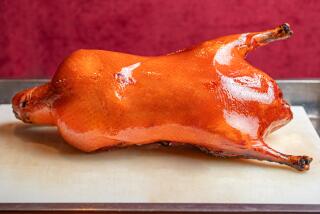China relishes carp, but U.S. fish may not find a market there
- Share via
Reporting from Shanghai — Keith Jones takes his family out for a special meal of bighead carp whenever his Chinese in-laws are in town.
At dinner this spring in Aiwanting Restaurant in a trendy Shanghai shopping district, Jones’ in-laws help devour a massive carp head. The fish is steamed in an oily, orange-colored broth, covered in spicy red peppers and cut in half lengthwise so the family can attack both sides. They eat the skin, pick out the little bones in the white fish and savor their favorite part — the fatty bit behind the eye.
Jones, from Britain, has lived in Shanghai for three years with his Chinese wife and their daughter — long enough to know that the freshness of the cherished carp is of top importance to Chinese diners.
That’s why carp eaters in this southern China city say they would never eat frozen fish from American lakes and rivers, even though scientists say they believe fishing is one of the best short-term solutions for controlling invasive Asian carp as they threaten the Great Lakes.
Big River Fish, a processor in Pearl, Ill., says it has a deal to ship Asian carp to Beijing to serve at high-end restaurants.
But in Shanghai, residents say the only frozen fish they eat is from the ocean. Freshwater fish must be eaten within hours of being killed.
“The company will have no channels to sell them here,” Jones’ mother-in-law, Liu Guilou, said through a translator, referring to Big River Fish.
Bighead carp, called “hua lian” in Mandarin, has been a Chinese delicacy for so much of China’s history that many in Shanghai say they like to eat it simply because it’s traditional.
Local supermarkets, small grocers and street-side sellers comply, offering live fish in tanks or in low plastic trays and then butchering them on site.
At a Shanghai Carrefour supermarket, a sign says the fish come from Hongze Lake, China’s fourth-largest lake, about 200 miles northwest of Shanghai. But Gui Jin Yu, who works the Carrefour fish counter, says most of the fish are farmed locally.
Most customers buy only the treasured head of the carp, which commands twice the price of the fish’s bottom half. At about $4.30 for a 4-pound fish head — a pricey dinner by Chinese standards — bighead carp also is twice as expensive as other comparable fish.
In Shanghai, people eat carp three main ways: fried, then stewed in sweet-and-salty soy sauce with ginger and green onions; in a soup, sometimes kept boiling and used to cook other raw meats at spicy Sichuan hot-pot restaurants; and, in a famed but difficult preparation from Hunan province, steamed in garlicky broth and topped with fresh-cooked red peppers.
The last preparation is difficult and time-consuming, so families such as Jones’ often go to local restaurants to eat it on special occasions. It’s the signature dish of the high-end Aiwanting Restaurant, where diners step off an elevator into a lobby dotted with pillar-shaped tanks of huge swimming goldfish.
A small order of Aiwanting’s fish heads and peppers costs 78 yuan, or about $12, which would purchase four to eight dishes at most everyday Chinese eateries. (The dish sells for about half that price at a lower-end Shanghai restaurant.) After a 15-minute wait, the Aiwanting wait staff delivers a huge fish head, its two halves still connected, cut off just behind the gills and the side fins. The soft red peppers and their spicy seeds are poured over the top.
Diners dig in with chopsticks, patiently pulling out tiny bones laced through the white flesh to enjoy the pleasant heat infused by the peppers and broth. The peppers even hide some of the ultra-fishy taste in the gills and the egg-white-like fat around the face.
As is common at Shanghai restaurants, Aiwanting buys carp every morning. It’s killed at the market and eaten later that day.
“We want to keep the freshness and quality,” the manager, Luo Huayong, said through a translator. “It loses its freshness if it’s not eaten the same day.”
More to Read
Inside the business of entertainment
The Wide Shot brings you news, analysis and insights on everything from streaming wars to production — and what it all means for the future.
You may occasionally receive promotional content from the Los Angeles Times.










